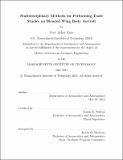| dc.contributor.advisor | Karen E. Willcox. | en_US |
| dc.contributor.author | Kays, Cory Asher | en_US |
| dc.contributor.other | Massachusetts Institute of Technology. Department of Aeronautics and Astronautics. | en_US |
| dc.date.accessioned | 2013-11-18T20:41:12Z | |
| dc.date.available | 2013-11-18T20:41:12Z | |
| dc.date.copyright | 2013 | en_US |
| dc.date.issued | 2013 | en_US |
| dc.identifier.uri | http://hdl.handle.net/1721.1/82485 | |
| dc.description | Thesis (S.M.)--Massachusetts Institute of Technology, Dept. of Aeronautics and Astronautics, 2013. | en_US |
| dc.description | This electronic version was submitted and approved by the author's academic department as part of an electronic thesis pilot project. The certified thesis is available in the Institute Archives and Special Collections. | en_US |
| dc.description | Cataloged from department-submitted PDF version of thesis | en_US |
| dc.description | Includes bibliographical references (p. 99-102). | en_US |
| dc.description.abstract | Multidisciplinary design optimization (MDO) is becoming an essential tool for the design of engineering systems due to the inherent coupling between discipline analyses and the increasing complexity of such systems. An important component of MDO is effective exploration of the design space since this is often a key driver in finding characteristics of systems which perform well. However, many design space exploration techniques scale poorly with the number of design variables and, moreover, a large-dimensional design space can be prohibitive to designer manipulation. This research addresses complexity management in trade-space exploration of multidisciplinary systems, with a focus on the conceptual design of Blended Wing Body (BWB) aircraft. The objectives of this thesis are twofold. The first objective is to create a multidisciplinary tool for the design of BWB aircraft and to demonstrate the performance of the tool on several example trade studies. The second objective is to develop a methodology for reducing the dimension of the design space using designer-chosen partitionings of the design variables describing the system. The first half of this thesis describes the development of the BWB design tool and demonstrates its performance via a comparison to existing methods for the conceptual design of an existing BWB configuration. The BWB design tool is then demonstrated using two example design space trades with respect to planform geometry and cabin bay arrangement. Results show that the BWB design tool provides sufficient fidelity compared to existing BWB analyses, while accurately predicting trends in system performance. The second half of this thesis develops a bi-level methodology for reducing the dimension of the design space for a trade space exploration problem. In this methodology, the designer partitions the design vector into an upper- and lower-level set, wherein the lower-level variables essentially serve as parameters, in which their values are chosen via an optimization with respect to some lower-level objective. This reduces the dimension of the design space, thereby allowing a more manageable space for designer interaction, while subsequently ensuring that the lower-level variables are set to "good" values relative to the lower-level objective. The bi-level method is demonstrated on three test problems, each involving an exploration over BWB planform geometries. Results show that the method constructs surrogate models in which the sampled configurations have a reduction in the system objective by up to 4 % relative to surrogates constructed using a standard exploration. Furthermore, the problems highlight the potential for the framework to reduce the dimension of the design space such that the full space can be visualized. | en_US |
| dc.description.statementofresponsibility | by Cory Asher Kays. | en_US |
| dc.format.extent | 102 p. | en_US |
| dc.language.iso | eng | en_US |
| dc.publisher | Massachusetts Institute of Technology | en_US |
| dc.rights | M.I.T. theses are protected by
copyright. They may be viewed from this source for any purpose, but
reproduction or distribution in any format is prohibited without written
permission. See provided URL for inquiries about permission. | en_US |
| dc.rights.uri | http://dspace.mit.edu/handle/1721.1/7582 | en_US |
| dc.subject | Aeronautics and Astronautics. | en_US |
| dc.title | Multidisciplinary methods for performing trade studies on blended wing body aircraft | en_US |
| dc.type | Thesis | en_US |
| dc.description.degree | S.M. | en_US |
| dc.contributor.department | Massachusetts Institute of Technology. Department of Aeronautics and Astronautics | |
| dc.identifier.oclc | 862232811 | en_US |
